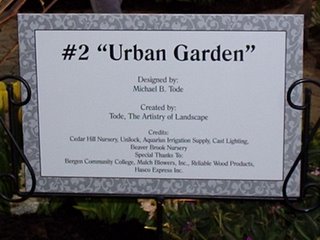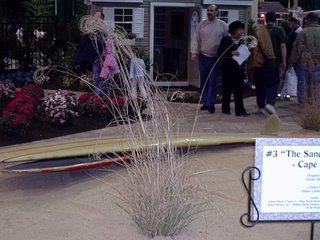Way back in April of last year when I first discovered Rutgers Gardens via a class on dividing perennials, one of the beds we worked on was in what they called "The Display Gardens". Well, there were beds laid out in a formal pattern, but there wasn't much of a display. The bed we were working on was one of two parallel outer beds that contained perennials (naturally), but the inner beds appeared to be completely empty. At the time, I thought it was strange. Shouldn't they also contain perennials or at least bulbs? What kind of "display" was there supposed to be?
I didn't get back to Rutgers Gardens until September when I took a class on garden photography. When we went out into the gardens to take pictures, one of the places we visited was the Display Gardens. They were spectacular, an absolute riot of color. And almost exclusively annuals which explained why they had been empty in the spring. I also discovered that there was a huge veggie plot in the back. I was still puzzled. I couldn't figure out what the design was supposed to be. Normally a formal garden has a very formal design of some sort. This one had none. Each bed was different. Different colors, different flowers, different layout.
The mystery was finally solved when I went back at the end of September for my orientation as a new volunteer.
The Donald B. Lacey Display Garden is run on a system known as "Adopt-a-Plot". Each bed is "adopted" by one or more volunteers who are responsible for planting and maintaining it. The only requirements are that they incorporate the annual theme, use only annuals and plant nothing that is more than three feet high in the flower beds. I remember stopping dead in my tracks when I heard this. Anyone could have a garden? Where do I sign up?
I signed and returned my contract in January. At that time, I also learned a little more about the Display Gardens. There are individual flower beds and veggie beds and committee flower beds and veggie beds. The committee beds are maintained by several volunteers and are planted according to a definite plan. There is one that spells out the year. There's a butterfly garden, an herb garden, a dried flower garden, etc. You are assigned your individual bed and committee bed by the Volunteer Coordinator. That's the same nice lady who got me involved in
the newsletter for the Master Gardeners.
We had our first meeting tonight and received our information packets. I was sure because it was my first time doing this that I would be assigned a tiny plot way in the back of the garden. To my surprise, I have a plot right in front and next to the central water garden. How funny is that? I have a fixation about water in the landscape! My committee bed is the herb garden. Also exciting since I read the
book on herbs in December. I am planning on incorporating more herbs in my gardens at home in addition to the herb garden I am doing as part of my Master Gardener training.
I'm working on scanning a copy of the garden diagram into my computer. It has everyone's names on the beds which I want to delete before publishing it here.
Are you convinced that I have totally lost my mind? I'm going to have gardens in three different towns this year! My own in Middlesex, my plots at Rutgers Gardens in New Brunswick and the herb and veggie beds for the Master Gardener program in North Brunswick. It's the gardens at Rutgers Gardens that I am most excited about. I find the thought of having my own garden in a public garden where thousands of people will see and (hopefully) admire it just thrilling.
 This is not a very good picture. It is difficult to get a good picture of this bunch. They are in front of my house in what used to be the side of the front bed. Then the slab next to it got removed during a porch/sidewalk renovation. I can't get close to them now without walking on a whole lot of other stuff.
This is not a very good picture. It is difficult to get a good picture of this bunch. They are in front of my house in what used to be the side of the front bed. Then the slab next to it got removed during a porch/sidewalk renovation. I can't get close to them now without walking on a whole lot of other stuff.























































